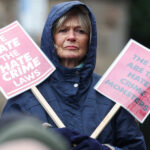Published November 2, 2006
New York’s St. Patrick’s Cathedral might be the most famous Catholic church in America, but Baltimore’s old cathedral — the Basilica of the National Shrine of the Assumption of the Blessed Virgin Mary, to use its proper name — is indisputably the most historic. Now, after a two-and-a-half-year, $32 million restoration, all Americans beginning on Saturday can discover this marvel of federal period architecture as its designers intended: an architectural expression of the American commitment to religious freedom, the first of human rights. And in that discovery, we find ourselves challenged by some of the most urgent questions of our time.
We can thank two 19th-century men of genius for the Baltimore Basilica’s classic proportions and luminous interior. One, Archbishop John Carroll, was the first Roman Catholic bishop of the newborn USA; the other, Benjamin Henry Latrobe, was the foremost American architect of the day, a friend of Thomas Jefferson, and the first architect of the U.S. Capitol.
John Carroll (a cousin of Charles Carroll of Carrollton, Md., the last surviving signer of the Declaration of Independence) wanted the country’s first cathedral to speak in a distinctively American architectural idiom and to embody the Catholic commitment to the First Amendment’s guarantee of religious freedom.
So Carroll turned to Latrobe, the son of a Moravian pastor, and Latrobe (who likely consulted Jefferson)produced an American adaptation of classical design that deployed diffused light to express the freedom the human spirit must enjoy in its response to God. The result was a cathedral church whose stateliness and luminosity express a profound respect for what Pope John Paul II, who prayed in the Baltimore Basilica in October 1995, called “the sanctuary of conscience.”
Where are we today?
The recently completed restoration of the building offers more than a reminder of the genius of the past, however; Carroll’s and Latrobe’s work has a special resonance for the present and the future. For to enter the restored Baltimore Basilica — a great American shrine to the centrality of religious freedom in any serious scheme of “human rights” — is to be confronted with two of the most crucial items on the world agenda today: The first — how do things stand with religious freedom? — is a question of particular, although not exclusive, interest to people of faith. The second — how does the human race engage its deepest differences (which are religious differences) with civility, tolerance and respect? — is a question for everyone.
Although few of us recognize it, the 20th century was the greatest century of persecution of Christians in history, with tens of millions murdered “in hatred of the faith” by totalitarian ideologies. With the collapse of fascism, and then communism, a new springtime of religious freedom seemed on the historical horizon. Yet the dramatic exodus of Christians from the Holy Land, the genocide in the south of Sudan, and the entire arc of conflict between Christianity and jihadist Islam that spans the globe from the west coast of Senegal to the east coast of Timor reminds us that the 21st century could well be a century of martyrdom, too. To visit the restored basilica and reflect on the centuries of struggle for religious freedom that it has witnessed is to be reminded that freedom is never free.
Then there is the question of how a world of profound religious differences manages those differences in ways that lead to increased understanding rather than intensified conflict. The temptation, often, is to think that indifference to differences is the path to tolerance.
The basilica suggests a different lesson: that the most secure foundation for religious freedom is, as Father Richard John Neuhaus once put it, the conviction that “it is the will of God that we be tolerant of those who disagree with us about the will of God.” That conviction is at the root of America’s success in maintaining the First Amendment commitments the Baltimore Basilica celebrates: Religious freedom in the USA is largely a religious accomplishment. That experience of conviction fostering tolerance has important lessons for a 21st-century world in which hundreds of millions of Muslims are contesting for the soul of their ancient faith. Will the men and women of peace in the house of Islam develop Islamic arguments for civility and tolerance, or will the jihadists who have declared war on the world (and often on their fellow Muslims) win?
The defense of freedom
A fascinating document touching a long forgotten part of the Baltimore Basilica’s past recently came to light at nearby Fort McHenry, whose bombardment during the War of 1812 caused Francis Scott Key to write the Star Spangled Banner. Had Fort McHenry fallen, the walls of the basilica, which rests on the highest hill in downtown Baltimore, were to be manned as the last line of defense against the British army. It seems, somehow, appropriate, because Baltimore’s old cathedral has always been an important part of a line of defense: the defense of religious freedom.
Now, in an age when religious freedom is under threat, not from atheistic ideologies but from irrational violence in the name of God, the restored Baltimore Basilica is more than a stunningly beautiful building — although it is surely that. It also invites every visitor to be a defender of the “sanctuary of conscience” in which humanity carries on its conversation with God.
George Weigel is Distinguished Senior Fellow of the Ethics and Public Policy Center in Washington, D.C. and holds EPPC’s William E. Simon Chair in Catholic Studies.








